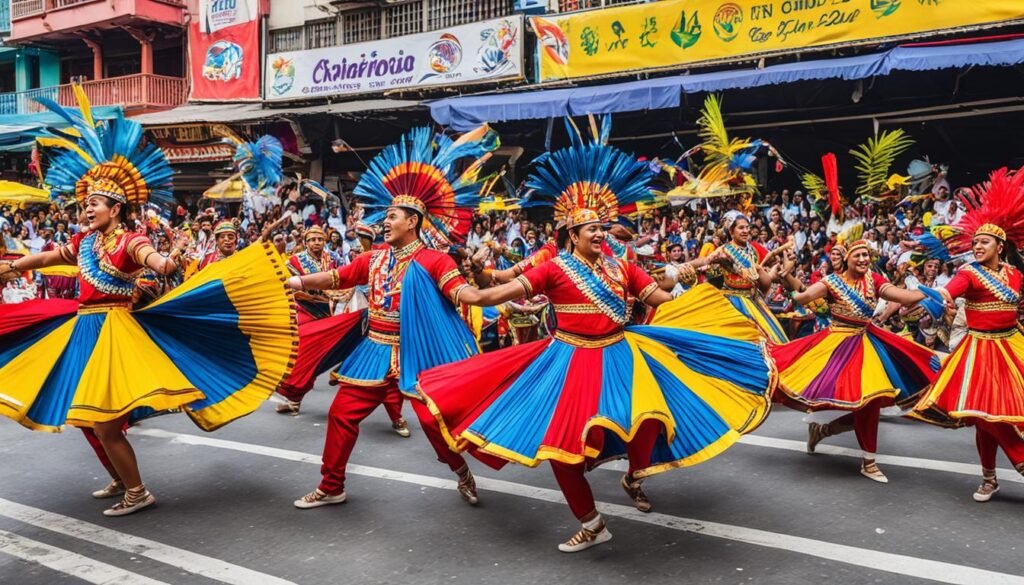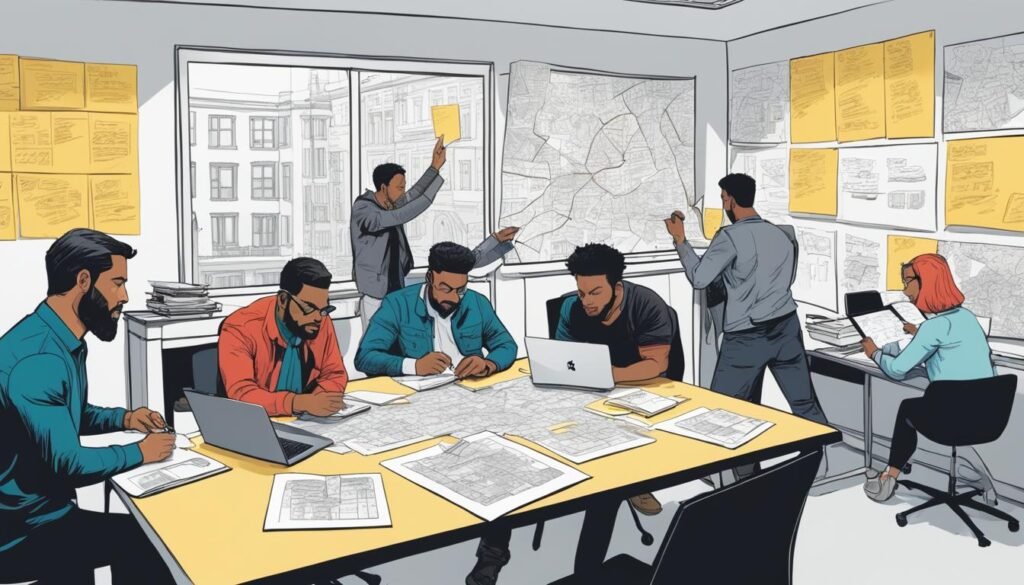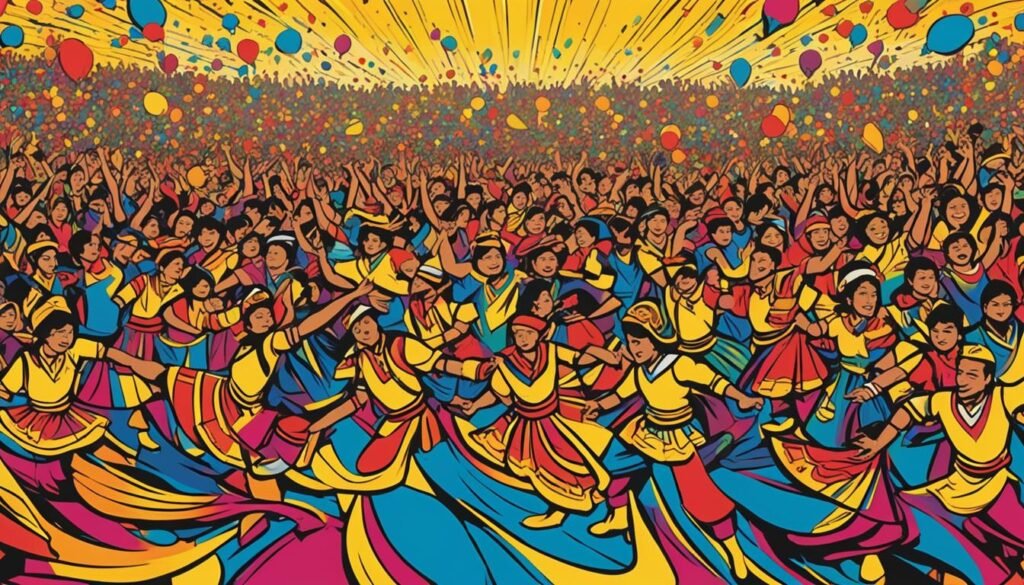The inaugural Sinulog Dance Contest took place in the year 1980, marking the beginning of one of the biggest festivals in the Philippines. This event showcased the rich cultural heritage of Cebu City and celebrated the devotion to the Santo Niño, the Child Jesus. The first dance contest paved the way for the colorful and vibrant Sinulog Festival that we know today.
Key Takeaways:
- The Sinulog Dance Contest originated in 1980, kickstarting the Sinulog Festival.
- The contest celebrates the cultural heritage of Cebu City and the devotion to the Santo Niño.
- The Sinulog Festival is now one of the biggest festivals in the Philippines.
- The contest showcases the talent, creativity, and cultural pride of the participants.
- The Sinulog Dance Contest has become an integral part of Filipino heritage and tradition.
Unveiling the Origin of Sinulog’s Dance Contest
The Sinulog Dance Contest has its roots in the religious and cultural traditions of the Philippines. The dance movements are deeply rooted in the religious practices of honoring the Santo Niño, the Child Jesus. Passed down through generations, these rituals have become an integral part of the Sinulog Festival, showcasing the devotion and faith of the Filipino people.
However, the origins of the Sinulog Dance Contest can be traced back to a significant historical event. It was the arrival of Ferdinand Magellan in the Philippines in 1521 that marked the introduction of Christianity to the archipelago. Magellan brought with him the image of the Child Jesus, which would later become the centerpiece of the Sinulog Festival.
“Ferdinand Magellan’s role in the history of the Sinulog Festival cannot be understated. His mission to spread Christianity in the Philippines brought about the devotion to the Santo Niño, which eventually gave birth to the vibrant and colorful festival we know today.”
The image of the Child Jesus, also known as the Santo Niño, holds both religious and cultural significance. In the Philippine context, the Santo Niño represents the acceptance of Christianity and the rejection of animist beliefs. The Sinulog Festival, with its joyful dances and vibrant celebrations, embodies the fusion of these religious and cultural elements, creating a unique and captivating spectacle.
To truly understand the Sinulog Dance Contest, one must appreciate its deep connection to the religious and cultural heritage of the Philippines. It is a testament to the country’s rich history and serves as a reminder of the enduring faith and traditions of the Filipino people.
Celebration of Faith and Filipino Heritage
The Sinulog Dance Contest is a celebration of faith and Filipino heritage. It showcases the rich cultural traditions of the Philippines and embodies the deep-rooted devotion to the Santo Niño, the Child Jesus. As participants take the stage, they perform intricate and ritualistic dance movements that have been passed down through generations, honoring their ancestors and expressing their spirituality.
Ritualistic Dance Movements Explained
The dance movements performed during the Sinulog Dance Contest are not merely choreographed routines but hold significant ritualistic meaning. Each hand gesture, footstep, and body movement carries symbolism that reflects the religious and cultural beliefs of the Filipino people. These movements convey stories of faith, gratitude, and reverence for the Santo Niño, creating a mesmerizing spectacle that captivates both participants and spectators alike.
Symbology of the Child Jesus in Sinulog Festivities
The Child Jesus, or Santo Niño, is at the heart of the Sinulog Festivities. Representing the acceptance of Christianity in the Philippines, the Child Jesus holds a special place in the hearts of the Filipino people. In the Sinulog Dance Contest, the dancers embody the symbology of the Child Jesus through their movements, symbolizing their unwavering faith and devotion. The vibrant and energetic dance performances portray the joy and gratitude felt by the Filipino community for the blessings bestowed upon them.
https://www.youtube.com/watch?v=MPvnZILn6EY
| Movement | Symbology |
|---|---|
| Hand raising | Expressing gratitude and praise to the Child Jesus |
| Foot stomping | Rhythmically driving away evil spirits |
| Forward thrusting | Symbolizing the triumph of Christianity over animist beliefs |
| Rotation and spinning | Emulating the joy and happiness felt in the presence of the Child Jesus |
These dance movements, along with various other elements, come together to create a truly awe-inspiring performance that celebrates faith, Filipino heritage, and the unbreakable bond between the people and the Child Jesus.
Birth of the Sinulog Festival
The Sinulog Festival originated from the fusion of pagan and Christian traditions in Cebu City. It traces its roots back to the simple dance rituals performed by the locals long before the arrival of Christianity. However, it was during the arrival of Ferdinand Magellan in 1521 that the first dance performance took place, marking a significant moment in the festival’s history.
Fusion of Pagan and Christian Traditions
The Sinulog Festival is a testament to the blending of pagan and Christian beliefs. Prior to the Spanish colonization, the indigenous people of Cebu City practiced paganism, which involved various dance rituals. With the arrival of Christianity, the locals incorporated their existing dance traditions into the newly introduced religious practices, creating a unique blend of cultural expressions. This fusion of traditions laid the foundation for the vibrant and dynamic Sinulog Festival we know today.
Tracing Back to the First Dance Performance
The first dance performance that paved the way for the Sinulog Festival occurred during Ferdinand Magellan’s arrival in 1521. It was a ceremonial dance performed by the indigenous people of Cebu City, showcasing their reverence for the Santo Niño, the image of the Child Jesus. This dance eventually evolved into the Sinulog Dance, which became the centerpiece of the Sinulog Festival. Therefore, the first dance performance holds great historical and cultural significance, as it set in motion the birth of the festival.

Inception of the Sinulog Dance Contest
The Sinulog Dance Contest was first introduced in 1980 as part of the Sinulog Festival. This marked the beginning of a competition that would showcase the talent, creativity, and cultural pride of the participating contingents. The inclusion of the dance contest added a new dimension to the festival, attracting more participants and spectators.
Behind the Scenes: Organizing the First Contest
The first Sinulog Dance Contest was organized by David Odilao, who was the Regional Director of the Ministry of Sports and Youth Development at that time. The government played a crucial role in the organization and promotion of the contest, ensuring its success and continuity. The formation of annual traditions, including the Sinulog Festival and the dance contest, was a testament to the efforts of the organizers and the support from the government.

The Evolution of Sinulog Festival Costumes
Over the years, the costumes worn by the participants of the Sinulog Dance Contest have evolved. The costumes are known for their vibrant colors and intricate designs. The use of bright colors symbolizes the joy and celebration of the festival, while the intricate designs showcase the creativity and craftsmanship of the Filipino artisans.
The Sinulog Festival is a feast for the eyes, with participants donning elaborate and mesmerizing costumes that captivate the audience. These costumes have undergone an evolution, reflecting the changing trends and styles that have emerged throughout the years.
One of the most striking features of Sinulog costumes is the use of bright colors. Vibrant shades of red, yellow, blue, and green dominate the costumes, creating a visual spectacle that complements the dynamic dance performances. These bright colors symbolize the energy, enthusiasm, and festive spirit of the Sinulog Festival.
In addition to the bright colors, Sinulog costumes are characterized by intricate designs. These designs are meticulously crafted, featuring intricate patterns and embellishments that showcase the creativity and artistry of the Filipino artisans. Every stitch and detail is carefully considered, resulting in costumes that are not only visually stunning but also rich in cultural symbolism.
The evolution of Sinulog costumes is a testament to the festival’s commitment to preserving and promoting Filipino cultural heritage. As new generations of performers and designers contribute their creativity and innovation to the festival, the costumes continue to evolve, embracing contemporary influences while staying true to their traditional roots.
The Sinulog Dance Contest is not only a showcase of talent and skill but also a celebration of Filipino craftsmanship and artistry. The costumes worn by the participants play a crucial role in bringing the performances to life, immersing the audience in the vibrant and magical world of the Sinulog Festival.
Music that Moves: The Rhythmic Foundation
The Sinulog Dance Contest is an exhilarating display of movement and rhythm, brought to life by the vibrant and energetic music that accompanies it. The rhythmic beats and melodies provide the foundation for the mesmerizing performances, enhancing the visual spectacle and capturing the essence of the Sinulog Festival.
Impact of Drums and Native Instruments
At the heart of the Sinulog music are the powerful beats of drums and the enchanting sounds of native instruments. The rhythmic and hypnotic drum beats set the pace and create an infectious energy that resonates throughout the performances. Native instruments such as the tambol and gong add depth and richness to the music, infusing it with a distinct local flavor.
Instrument table:
| Instrument | Description |
|---|---|
| Drums | The drums provide the driving force behind the music, creating a pulsating rhythm that fuels the dancers’ movements. |
| Tambol | The tambol, a traditional Filipino drum, adds a unique resonance to the music, contributing to the overall auditory experience of the Sinulog Festival. |
| Gong | The gong, with its deep and resonant sound, adds a distinctive cultural touch to the music, evoking a sense of tradition and heritage. |

Dance Contest
Insights from the First Contingents
The Sinulog Dance Contest showcases the talent and creativity of the participating contingents, each one bringing their unique style and interpretation to the stage. As the contest evolved over the years, insights from the first contingents provide a glimpse into the early years of the competition and the challenges they faced. These insights offer a valuable perspective on the growth and development of the Sinulog Dance Contest.
One of the main challenges faced by the first contingents was establishing a distinct identity and choreography that would stand out in the competition. The dancers had to work hard to create innovative routines that would captivate the audience and impress the judges. They experimented with different dance styles, cultural elements, and visual effects to make their performances memorable.
Another aspect that the first contingents had to navigate was the evolving competition criteria. As the Sinulog Dance Contest gained popularity, the organizers worked to establish fair and objective judging criteria that would effectively assess the performances. Initially, the criteria focused on technical skills, precision, and synchronization. However, as the contest matured, the criteria were expanded to include creativity, originality, cultural authenticity, and storytelling ability.
Evaluating the Dance Competition’s Criteria
The criteria used to evaluate the dance competition have evolved to ensure a comprehensive and equitable judging process. Today, the competition criteria encompass various elements, including:
- Creativity: Assessing the uniqueness of the choreography and the incorporation of innovative movements and formations.
- Artistry: Evaluating the dancers’ ability to express emotions, convey narratives, and captivate the audience through their performances.
- Technical Skills: Considering the dancers’ technique, precision, and synchronization to assess their mastery of the dance form.
- Cultural Authenticity: Recognizing the incorporation of traditional Sinulog movements, music, costumes, and storytelling that showcase the rich Filipino heritage and the festival’s origins.
- Visual Presentation: Evaluating the overall visual impact of the performance, including stage presence, costumes, props, and use of visual effects.
- Energy and Execution: Assessing the dancers’ stamina, coordination, and ability to maintain energy and enthusiasm throughout their routines.
The evolution of the competition criteria reflects the continuous growth and development of the Sinulog Dance Contest. It ensures that the performances are evaluated holistically, rewarding creativity, cultural authenticity, and technical excellence. The criteria provide a framework for the participating contingents to showcase their talents while honoring the festival’s traditions and the spirit of the Sinulog Dance Contest.
Global Recognition and Expansion of Sinulog Festival
The Sinulog Festival has gained global recognition and has expanded beyond Cebu City, becoming a renowned cultural event on an international scale. The festival’s vibrant celebrations, rich history, and captivating performances have captivated audiences worldwide, solidifying its position as one of the most significant festivals in the Philippines.
One of the remarkable acknowledgments received by the Sinulog Festival is being recognized as the ‘City of Culture’ by the Association of Southeast Asian Nations (ASEAN). This prestigious recognition solidifies the festival’s place as a distinguished cultural event that showcases the heart and soul of Filipino heritage.
The Sinulog Festival’s international appeal has attracted a multitude of tourists and participants from all corners of the globe, contributing to its global recognition. People from different cultures come together to witness the magnificent spectacle of music, dance, and artistry displayed during the festival. The Sinulog Festival has become a symbol of unity, bringing people closer through the appreciation and celebration of Filipino culture and heritage.
Conclusion
The first Sinulog Dance Contest holds a significant legacy in the history of the Philippines. It marked the beginning of the annual Sinulog Festival, which has become a cherished celebration of the country’s rich cultural heritage. Through the Sinulog Dance Contest, the devotion to the Santo Niño and the vibrant Filipino spirit are showcased on a grand stage.
As the Sinulog Festival continues to evolve, it faces the challenge of preserving its traditions in a modern world. In an era of rapid globalization and changing cultural dynamics, it is important to find a balance between honoring the past and embracing the future. The future of Sinulog lies in its ability to adapt to modern times while staying true to its roots.
While the challenges may be great, the future of Sinulog remains bright. It continues to be a beacon of cultural pride and diversity, attracting both local and international participants and spectators. Sinulog is not just a festival; it is a celebration of faith, a testament to the Filipino heritage, and a symbol of unity. With each passing year, Sinulog strengthens its place as a vibrant and enduring tradition in the hearts of the Filipino people.
FAQ
What is the significance of the Sinulog Dance Contest?
The Sinulog Dance Contest is a celebration of faith and Filipino heritage, showcasing the devotion to the Santo Niño through ritualistic dance movements.
How did the Sinulog Festival originate?
The Sinulog Festival originated from a fusion of pagan and Christian traditions, with its roots tracing back to the first dance performance during the arrival of Ferdinand Magellan in 1521.
When was the first Sinulog Dance Contest introduced?
The first Sinulog Dance Contest was introduced in 1980 as part of the Sinulog Festival, adding a new dimension to the celebration and attracting more participants and spectators.
Who organized the first Sinulog Dance Contest?
The first Sinulog Dance Contest was organized by David Odilao, the Regional Director of the Ministry of Sports and Youth Development at that time, with crucial support from the government.
How have the costumes for the Sinulog Dance Contest evolved over the years?
The costumes for the Sinulog Dance Contest have evolved with vibrant colors symbolizing the joy of the festival and intricate designs showcasing the creativity of Filipino artisans.
What role does music play in the Sinulog Dance Contest?
Lively and rhythmic music, often featuring drums and native instruments, sets the tone for the Sinulog Dance Contest, adding an auditory dimension to the visual spectacle of the performances.
How are the performances in the Sinulog Dance Contest evaluated?
The performances in the Sinulog Dance Contest are evaluated based on criteria that have evolved over time, ensuring fair and objective judging of the creativity, precision, and choreography of the participating contingents.
Has the Sinulog Festival gained international recognition?
Yes, the Sinulog Festival has gained global recognition and was acknowledged as the ‘City of Culture’ by the Association of Southeast Asian Nations (ASEAN), attracting tourists and participants from around the world.
What is the legacy of the first Sinulog Dance Contest?
The first Sinulog Dance Contest paved the way for the annual Sinulog Festival, showcasing the rich cultural heritage of the Philippines and preserving traditions. The future of Sinulog remains bright as it continues to be a vibrant celebration of faith, Filipino heritage, and cultural diversity.


